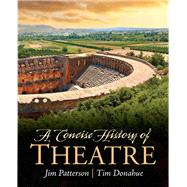This streamlined, engaging text helps students understand the events, places and people that have influenced the history of theatre.
Learning Goals
Upon completing this book, readers will be able to:
- Identify the major time periods and geographic areas associated with the history of theatre
- Distinguish relevant characteristics of theatre in diverse times and places.
- Describe the underlying cultural, economic, and political environments as they affected theatre in different times and places.
- Associate major participants who made theatre within their historical and regional context.









